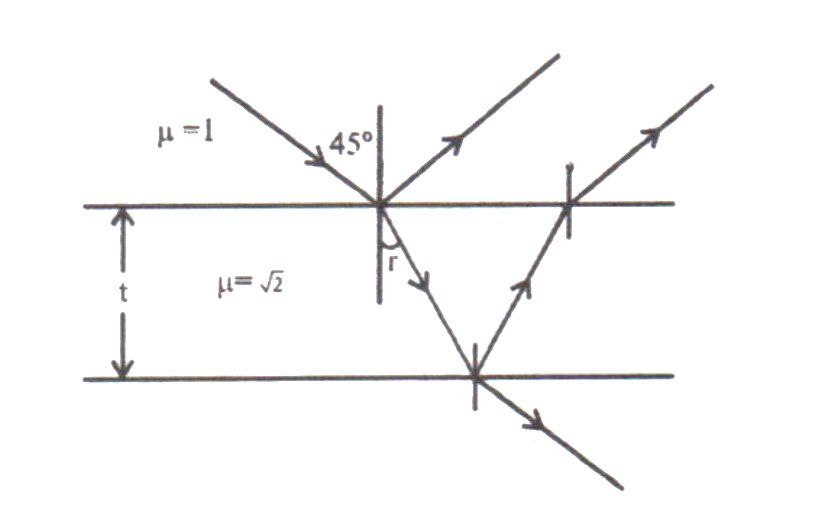What is the minimum thickness of thin film required for constructive interference in the reflected light through it ?
(Given, the refractive index of the film =1.5, wavelength of the lilght incident on the film =600 nm.
(a)100 nm
(b)300 nm
(c)50 nm
(d)200 nm
The correct Answer is:A
To find the minimum thickness of a thin film required for constructive interference in reflected light, we can follow these steps:
1. Understand the Condition for Constructive Interference:
The condition for constructive interference in a thin film is given by the formula:
2nt=(m+12)λ
where:
- n is the refractive index of the film,
- t is the thickness of the film,
- λ is the wavelength of the light in vacuum,
- m is an integer (0, 1, 2, ...).
2. Identify the Given Values:
- Refractive index n=1.5
- Wavelength of light λ=600nm=600×10−9m
3. Set Up the Equation for Minimum Thickness:
For minimum thickness, we use m=0:
2nt=12λ
4. Rearranging the Equation:
Rearranging the equation to solve for t:
t=λ4n
5. Substituting the Values:
Now, substitute the values of λ and n:
t=600×10−94×1.5
6. Calculating the Denominator:
Calculate 4×1.5:
4×1.5=6
7. Final Calculation:
Now substitute back to find t:
t=600×10−96=100×10−9m
Thus, the minimum thickness t is:
t=100nm
Final Answer:
The minimum thickness of the thin film required for constructive interference in the reflected light is 100 nm.
---
The condition for constructive interference in a thin film is given by the formula:
2nt=(m+12)λ
where:
- n is the refractive index of the film,
- t is the thickness of the film,
- λ is the wavelength of the light in vacuum,
- m is an integer (0, 1, 2, ...).
- Refractive index n=1.5
- Wavelength of light λ=600nm=600×10−9m
For minimum thickness, we use m=0:
2nt=12λ
Rearranging the equation to solve for t:
t=λ4n
Now, substitute the values of λ and n:
t=600×10−94×1.5
Calculate 4×1.5:
4×1.5=6
Now substitute back to find t:
t=600×10−96=100×10−9m
Thus, the minimum thickness t is:
t=100nm
The minimum thickness of the thin film required for constructive interference in the reflected light is 100 nm.
Topper's Solved these Questions
- RAY OPTICS AND WAVE OPTICS BOOK - VMC MODULES ENGLISHCHAPTER - RAY OPTICS AND WAVE OPTICS EXERCISE - EFFICIENT
49 Videos
- RAY OPTICS BOOK - VMC MODULES ENGLISHCHAPTER - RAY OPTICS EXERCISE - IN-CHAPTER EXERCISE-J
10 Videos
- REVISION TEST-15 JEE - 2020BOOK - VMC MODULES ENGLISHCHAPTER - REVISION TEST-15 JEE - 2020EXERCISE - PHYSICS
25 Videos
Similar Questions
What is the minimum thickness of a soap bubble needed for constructive interference in reflected light, if the light incident on the film is 750 nm? Assume that the refractive index for the film is n=1.33
View SolutionWhat is the minimum thickness of a thin film (μ=1.2) that results in constructive interference in the reflected light? If the film is illuminated with light whose wavelength in free space is λ=500nm ?
View Solution
Knowledge Check
What is the minimum thickness of a soap bubble needed for constructive interference in reflected light, if the light incident on the film is 750 nm? Assume that the refractive index for the film is n=1.33
A282 nmB70.5 nmC141 nmD387 nmThe colours seen in the reflected white light from a thin oil film are due to
ADiffractionBInterferenceCPolarisationDDispersion
Find the minimum thickness of a film which will strongly reflect the light of wavelength 589 nm. The refractive index of the material of the film is 1.25.
View SolutionCalculate the minimum thickness of a soap bubble film (μ=1.33)that results in constructive interference in the reflected light if the film is illuminated with light whose wavelength in free space is λ=600nm.
View SolutionA ray of light is incident at an angle of 45∘ (ralative to the normal) on a thin film of a liquid with an index of refraction of √2. Assuming that the medium of both sides of the film is air, find the minimum thickness of the film required for constructive interference in the reflected light for sodium light of wavelenght 600 nm.

View SolutionApproximate thickness of oil film to observe interference of light (due to which it looks coloured) is
View SolutionAn oil film covers the surface of a small pond. The refractive index of the oil is greater than that of water. At one point on the film, the film has the smallest non-zero thickness for which there will be destructive interference in the reflected light when infrared radiation with wavelength 800 nm is incident normal to the film. When this film is viewed at normal incidence at this same point, for what visible wavelengths, if any, will there be constructive interference? (Visible light has wavelengths between 400nm and 700 nm )
View SolutionIf we are to observe interference in a thin film, why must the film not be very thick (with thickness only on the order of a few wavelength)?
View Solution